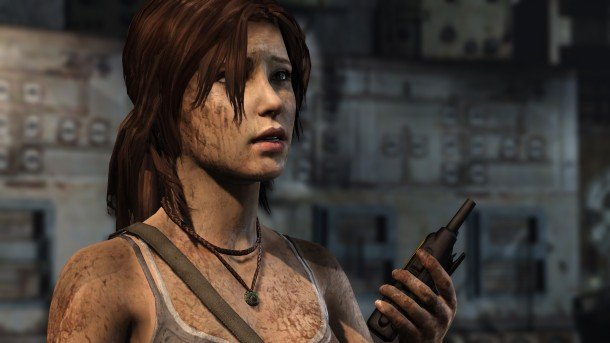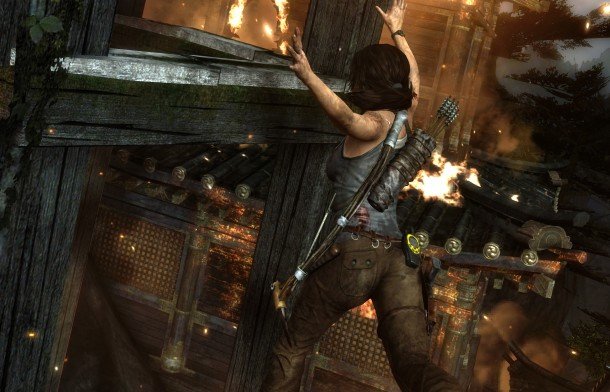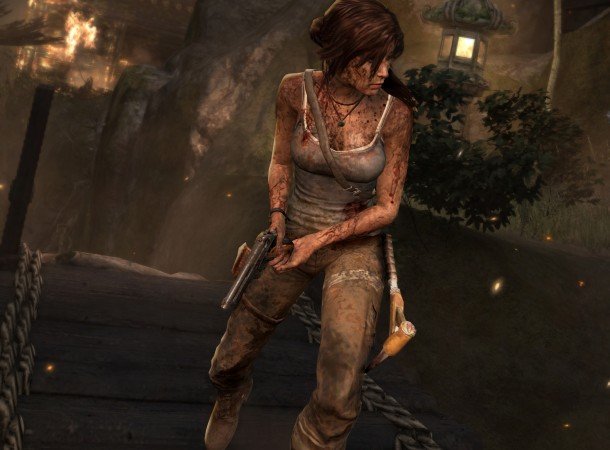Tomb Raider hands-on: "a lack of meaningful interaction"

This preview originally appeared in issue 248 of PC Gamer UK.
On screen, Lara Croft is inching her way up a rock face. She's wedged in a narrow vertical gap, chimneying her way up. It's complicated, gruelling work. She grunts as she works her way past outcrops, exerting herself totally with the effort of remaining suspended some 40 feet above the jagged ground below. She slips, losing her footing for a second, before she jams her boot against the wall, steadies herself, and heaves a lungful of air. She climbs on.
In a chair, I'm pushing the thumbstick on my gamepad forward. I've been pushing it forward for almost all of Lara's ascent. When she slips, I take my thumb off the controller for a second. I do this because the game makes it clear that I have no way to stop the event or assist in her righting process, and because my thumb is getting mildly numb from the effort. Three quarters of the way up, I release it again, interested to see what'll happen to a visibly knackered Lara left to dangle. Nothing. She stays there, wedged in the rock, her superhuman core strength keeping her legs stable for – presumably – eternity. I go back to pushing the thumbstick forward.

A quick note: I'm pushing the thumbstick forward – not pressing W on a keyboard – because journalists are only able to play Xbox 360 code at this stage in Tomb Raider's development. I've been pushing it forward for most of the three hours of Tomb Raider I've played so far, from Lara's shipwreck at the opening, through her escape from local madmen down a perilously narrow and conveniently sized cave, during lengthy climbs up the side of a variety of precarious structures and rock formations.
Sometimes, Lara slips and tumbles as I'm pressing the thumbstick forward: collapsing into a heap after diving past a falling rock, missing a handhold halfway up a radio mast. It's meant to feel thrilling, moments of near-death to keep the pulse racing. It succeeds instead in frustrating me. I can see the obvious coming, but I can't avoid it. I can't do anything but press the thumbstick forward as control is wrested away from me, keeping the scene rolling as Lara finds out about her own survival instincts on her own.
The closest parallel is the PlayStation 3's Uncharted series. But where the linear leaping of those games was leavened by Indiana-Jones-style humour and silliness, Tomb Raider is pitch black in tone. Lara starts the game by unceremoniously dropping onto a spike, which pierces her clean through and obliges her to clutch her side as she tries to escape from a cave. The idea is to express human frailty, but what it's doing is hamstringing a character defined by agility. For the next 20 minutes, Lara is left wheezing, gasping, and chattering her teeth, unable to sprint or jump thanks to the low cave roof, until she finds a fire at an island camp.

Tomb Raider opens up at this point. Lara's first camp is on the side of a bluff, where an overhanging rock provides shelter from the incessant rain. The fire provides a place to upgrade equipment and spend experience points. Upgrades are earned through the collection of salvage – found in containers strewn around the island – and applied to Lara's survival tools. I turn a makeshift pickaxe into a stronger makeshift pickaxe by applying some metal to it at one of these fires.
The biggest gaming news, reviews and hardware deals
Keep up to date with the most important stories and the best deals, as picked by the PC Gamer team.
A short way on, one of Lara's shipmates – all of whom seem to have survived the shipwreck and meet up with her shortly after her escape – leads me toward a vast temple door. He's an archaeologist, and needs Lara's help to turn the door's crank. I apply the newly upgraded pickaxe to the relevant hole, and get cranking.
The area around the temple is large and lush. Deer frolic nearby. A few minutes previously, I put an arrow through one of those hart's hearts when the game told me how hungry Lara was. There's no obvious debilitating effect to signify hunger, but the story wouldn't progress until I'd murdered Bambi's mother, so down she went.

Lara's longbow is just as effective a weapon against human targets, and offers the potential for a silent kill. I'm able to clear out a whole camp by loosing arrows into necks as backs are turned, making Lara Croft play like a bruised version of Sam Fisher.
The open areas around the camps can feel more like a staging posts than places to truly explore: regions to collect stuff and gather your thoughts before being funnelled through a cave or a tunnel. Pressing on, I find some welcome offshoots. Tombs are small, self-contained, and optional. I find one and creep in, solving a weight-based puzzle to nick some treasure. Once done, I make my way back and rejoin the main path, pushing Lara's story forward. Always pushing forward.
Crystal Dynamics want players to guide Lara through adversity, to help her find her strength and will to survive. Her predicament looks harrowing, but such is the lack of meaningful interaction, she might do just fine without your help.

